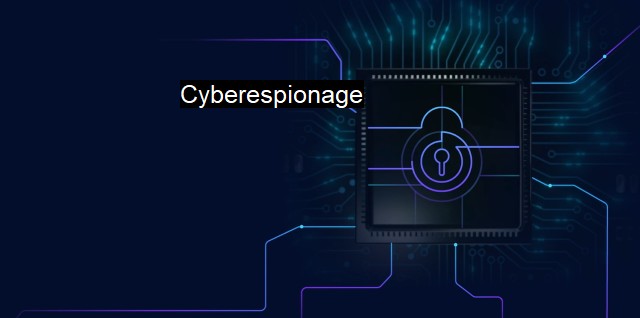What is Cyberespionage?
Cyberespionage: The Threat of Hacking for Espionage and Monetary Gain and the Critical Role of Cybersecurity in Defense"
Cyberespionage, a significant term refers to the use of digital tools and techniques to steal, compromise, or manipulate confidential data or intellectual property from an adversary for strategic, competitive, or security purposes. This phenomenon has rapidly evolved amid the widespread digitalization of business processes, systems, and communications, posing an extensive range of threats to both governmental and non-governmental entities worldwide.In the era of information technology and digital transactions, the security provisions ensuring data integrity and privacy fall within the ambit of cybersecurity which is challenged by cyberespionage. Cyberespionage innately embodies malicious activities targeted at breaching digitally-stored data, altering system configurations, and surreptitiously controlling systems without the user discovering these infiltrations.
Generally, spying involves the unlawful infiltration of systems using myriad ways, including but not restricted to malware, social engineering, exploit packages, or Advanced Persistent Threats (APTs). It often exploits system vulnerabilities that can be mitigated by implementing efficient cybersecurity measures and robust antivirus solutions.
Primarily, cyberespionage campaigns are known for their degree sophistication. They are commonly associated with nation-states or large-scale corporations with political, military, or economic motives rather than petty cybercriminals in search of short-term, monetary gains. The scale of cyberespionage can range from the theft of sensitive governmental military strategies to the filching of commercial trade secrets, thus broadly affecting national security and economic competitiveness.
Antivirus software plays a crucial role in countering cyberespionage. By routinely scanning for and removing malware, detecting and mitigating system vulnerabilities, and tightly sealing any possible loopholes invaders might exploit, antivirus plays an essential part in fortifying cybersecurity defenses. with human errors often facilitating cyberespionage, advanced antivirus softwares are deploying features like phishing protection and malicious website alerts, proving instrumental in improving user awareness and preventing inadvertent data breaches.
Yet, the cyberespionage landscape continues to evolve, consistently outthinking and challenging antivirus solutions and cybersecurity measures with innovative strategies. Meanwhile, the increasing reliance on cloud technology and its inherent security pitfalls offer a potent playground for cyberespionage actors, testing the quanto-mechanical limit of cybersecurity.
As entities realise the significance of cybersecurity against cyberespionage, they are developing strategic plans comprising of dynamic risk mitigation techniques, contingency plans, and robust disaster recovery plans. These plans employ avant-garde cybersecurity measures that include Information Rights Management (IRM), Identity Access Management (IAM), and state-of-the-art antivirus software.
Training end-users about the sophistication and detrimental calamity of cyberespionage effectively curbs inadvertent human errors. Security awareness programs often contain information about identification of suspicious email attachments or phishing attempts, strengthening passwords, understanding sharing permissions and endorsing safe cyber practices.
Cyberespionage’s potential impacts are colossal, including financial losses, reputational damage, operational disruptions, or compromised national security. These threats emphasize the necessity for robust cybersecurity strategies and powerful antivirus tools, highlighting their importance for an organization’s overall resilience in today's interconnected digital world. The battle against cyberespionage, therefore, is an ongoing effort in which remaining vigilant, prepared and continuously updating cybersecurity and antivirus mechanisms is not an option; it remains an imperative defensive maneuver and is undoubtedly a significant investment for a secure digital future.

Cyberespionage FAQs
What is cyberespionage?
Cyberespionage refers to the act of stealing sensitive information or trade secrets from individuals, businesses or governments through the use of electronic communication networks, such as the internet.What are the consequences of cyberespionage?
Cyberespionage can lead to significant financial losses, damage to reputation, and loss of sensitive data such as intellectual property, customer information, and trade secrets. It can also lead to national security threats if the stolen data pertains to government secrets.How can organizations protect themselves from cyberespionage?
Organizations can protect themselves from cyberespionage by implementing strong cybersecurity measures, such as using anti-virus software, firewalls, and encryption technologies. They should also train their employees on how to identify and report suspicious activities and implement access controls to prevent unauthorized access to sensitive information.What are some examples of cyberespionage attacks?
Some of the most well-known examples of cyberespionage attacks include the hacking of the Democratic National Committee (DNC) during the 2016 US Presidential elections, the Stuxnet virus that targeted Iranian nuclear facilities, and the Chinese hacking of US defense contractors to steal military technology.| | A | | | B | | | C | | | D | | | E | | | F | | | G | | | H | | | I | | | J | | | K | | | L | | | M | |
| | N | | | O | | | P | | | Q | | | R | | | S | | | T | | | U | | | V | | | W | | | X | | | Y | | | Z | |
| | 1 | | | 2 | | | 3 | | | 4 | | | 7 | | | 8 | | |||||||